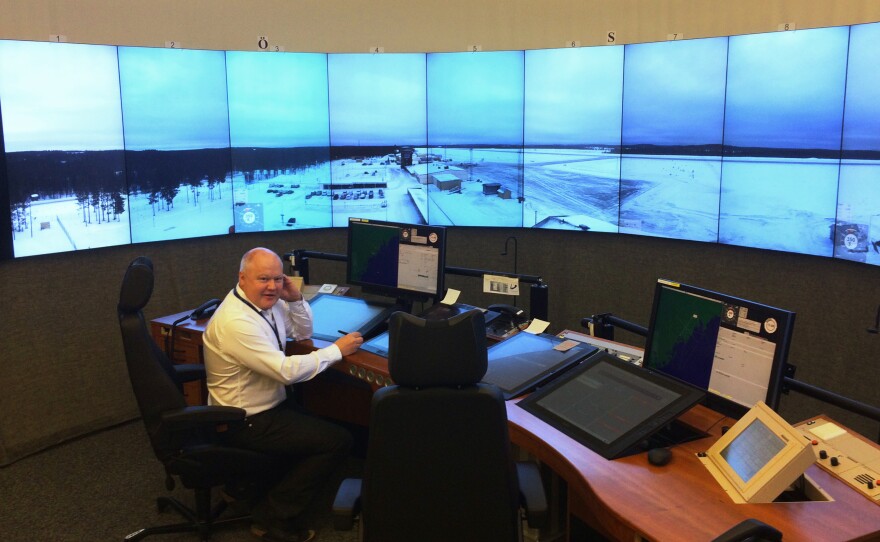
As our plane touches down in Sundsvall, Sweden, the horizon is all snow and ice. A small air traffic control tower sticks out above the white horizon.
But this airport actually has two air traffic control centers. The second one is just a short walk from the airport runway.
Inside a ground-floor, windowless room, there's a display that looks exactly like what you'd see out of an air traffic control tower. You can see the snowy runway, you can see the trees, you can even see a car pulling into the airport parking lot.
But instead of windows, these are actually screens. And the airport you're looking at isn't the one in Sundsvall. It's the one in Ornskoldsvik, Sweden — about 105 miles away.
Ornskoldsvik is the first airport in the world to land passenger planes remotely. This summer, an airport in Leesburg, Va., will become the first American airport to use the new technology.
Erik Backman runs the remote airplane landing center in the town of Sundsvall. He explains that the town of Ornskoldsvik has a tiny airport, and it's expensive to keep air traffic controllers there who spend hours with no planes to land.
So they decided to have one team in Sundsvall that could handle both cities.
"The day you have one air traffic controller who can control two airports, then you have some good benefits according to costs," Backman says.
A 'Paradigm Shift' For The Industry
In Ornskoldsvik, a set of cameras and microphones delivers a real-time image to Sundsvall. Of course, new technology is notoriously glitchy.
And a problem landing an airplane is far more consequential than a laptop freezing up.
Backman says when he saw the first mockup of this technology in 2004, he was dubious. The room had to be dark, the pictures were jumpy.
But a decade later, they've been landing planes remotely for months without any major problems.
Mikael Henriksson, the project manager, has been an air traffic controller for 40 years. He says in all his time looking out tower windows, there were only three big innovations: blinds to block out the sun, thicker glass to block out the noise, and bug zappers to get rid of the flies.
Now, he's had a chance to play with this new technology, and he can't believe it only arrived near the end of his career.
"For the air traffic controller, this is like airline pilots going from propeller to jet," Henriksson says. "It's a paradigm shift."
Many Uses, Including Potentially For The Military
Because once the windows are replaced with screens, you can overlay all kinds of information on the display: airplane numbers, runway incursion warnings. You can zoom in, or switch to an infrared view to see through thick fog or darkness.
And that might make this technology useful even for big, crowded airports.
Anders Carp is head of traffic management at Saab, the Swedish defense and security company that created this technology. He thinks there are worldwide — even military — applications.
Airports in dangerous places could have a camera house instead of a control tower, he says. The air traffic controllers could be a few — or a few thousand — miles away in a safe environment, because it doesn't matter whether the remote tower is across town or on the other side of the earth.
Back in the Sundsvall control center, a plane descends toward the Ornskoldsvik runway. We watch it move across the screen. The sound shifts in stereo as the plane rolls along.
The passengers — and even the pilot — have no idea whether they've been brought in for a landing from the tower they can see out their window, or from this hidden, remote center more than a 100 miles away.
Copyright 2015 NPR. To see more, visit http://www.npr.org/.






